-
 1942 Inglis Mk1 Bren Gun
1942 Inglis Mk1 Bren Gun
I managed to find time to put together a photo montage of my newly arrived 1942 Inglis Mk1 Bren Gun, deactivated, but full cock and click and complete with original Bren Gun transit case marked 9974.
The receiver is marked with original '42 date, but also has 1.51.FTR. above the '42 date, which I believe means "Factory Thorough Repair" in January 1951?.
There were also 3 sets of paperwork with one showing Australian Military Forces form AAF F114 "Inspection of Equipment Document" dated May 1953 and bearing chest ID 9974. This document indicates that the Bren was "Repaired Range Tested and Prepared for Issue".
Military Forces form AAF F114 "Inspection of Equipment Document" dated May 1953 and bearing chest ID 9974. This document indicates that the Bren was "Repaired Range Tested and Prepared for Issue".
There is a second Australian Military Forces form AAF F114 "Inspection of Equipment Document" dated the following year, May 1954 and bearing chest ID 9223, which is different from chest 9974 that came with this Bren Gun. This document indicates that the Bren was "Repaired, xxxxx Range Tested & Prepared for Issue". This document is hand written and I can't make out what the word with "xxxx" says, so if anyone else does, I'd appreciate knowing that.
The third document is an Australian Military Forces AAF F114 "Packing Note" D754049 dated Sept 30th, 1957, I think indicating the contents and it says "xxxx Bren Mk1 with Spare Barrel". Again, I can't make out what the "xxxx" says. Any guesses?
As required by Canadian firearms regulations, this piece has been deactivated at some in the past, but it's been done very well showing little visible defacing, plus one can cock and click fire the action. It has two small welds which can be seen in the photo montage and there's a pin driven through the barrel, just a little ways into the breech. The magazine has a small weld to prevent ammunition from being loaded, which I'm not sure why that was done, considering the other deactivation methods performed on the Bren itself.
firearms regulations, this piece has been deactivated at some in the past, but it's been done very well showing little visible defacing, plus one can cock and click fire the action. It has two small welds which can be seen in the photo montage and there's a pin driven through the barrel, just a little ways into the breech. The magazine has a small weld to prevent ammunition from being loaded, which I'm not sure why that was done, considering the other deactivation methods performed on the Bren itself.
Here's how she arrived.

(Click PIC to Enlarge)
Here's a link to a full 158 pic photo montage.
1942 Inglis Mk1 Bren Gun (Click Here)
Here's a some sample pics from the photo montage including scans of the original documentation that came in the Bren transit chest.
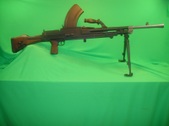 (Click PIC to Enlarge)
(Click PIC to Enlarge)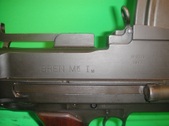 (Click PIC to Enlarge)
(Click PIC to Enlarge)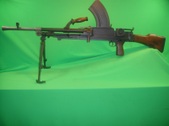
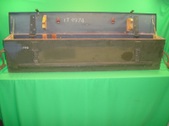 (Click PIC to Enlarge)
(Click PIC to Enlarge)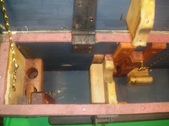 (Click PIC to Enlarge)
(Click PIC to Enlarge)
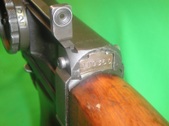 (Click PIC to Enlarge)
(Click PIC to Enlarge)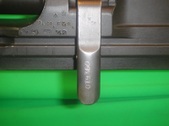 (Click PIC to Enlarge)
(Click PIC to Enlarge)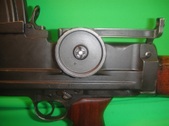
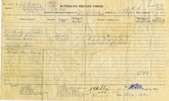 (Click PIC to Enlarge)
(Click PIC to Enlarge)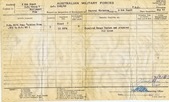 (Click PIC to Enlarge)
(Click PIC to Enlarge)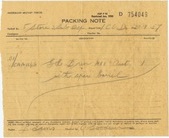
As I mentioned in my previous post titled It's arrived..., when I was a young trooper back in the early 60's, I trained on first the Sten SMG and Bren Gun, before they switched us over to the Sterling SMG and FNC2. I loved the old Bren and most of the guys I trained with preferred it over the FNC2, hating to see it retired....
However, after 48 years or so, I've forgotten so much about this old girl.
I can't wait to buy Peter Laidler 's forthcoming new book on the Bren Gun ......
's forthcoming new book on the Bren Gun ...... 
In the meantime, I'd appreciate as much information as Peter and the many other Bren experts here can provide, based upon the extensive photo montage and detailed close ups, particularly of the various markings and dates on different components. I did figure out that the JI mark meant John Inglis, which appears on many of the parts. There's also a few Australian military markings, indicating some rework done when they obtained it from the Canadian government back in the early 1950's.
To aid people in leaving feedback for everyone's benefit, I've opened up publicly the description area for each individual picture in the photo montage. So, please add you input for any picture and if there's already description text associated with a picture and you have more to include, simply add it to any existing text.
Finally, I'm looking for someone who would be willing to write a Knowledge Library article on the Bren Gun, using this piece and accompanying photo montage as a typical example. If you'd like to take a run at this for the benefit of all our members, send me an email and let me know.
article on the Bren Gun, using this piece and accompanying photo montage as a typical example. If you'd like to take a run at this for the benefit of all our members, send me an email and let me know.
Thanks in advance for any feedback ... 
Regards,
Doug
Information
 |
Warning: This is a relatively older thread
This discussion is older than 360 days. Some information contained in it may no longer be current. |
|
Last edited by Badger; 12-11-2012 at 07:33 AM.
-
The Following 8 Members Say Thank You to Badger For This Useful Post:
-
12-11-2012 07:28 AM
# ADS
Friends and Sponsors

-
Advisory Panel


If the mag hadn't been tack welded, it would have to be pinned to 5 rds according to our laws. Remember?
-
Thank You to browningautorifle For This Useful Post:
-
-
Advisory Panel


I would suggest that the lower receiver is a replacement, as well as the barrel nut. Serial number on the lower is different from what I am used to seeing on Inglis Brens, as well as the different finish from the upper. Barrel nut is Enfield produced. The butt also seems to have traces of the white band signifying DP. The butt also appears to have been replaced at one time, as evidenced by the Slaz manufacture. Interesting the C with the arrow through it. This is the same inspection mark we find on the Bren Plessey sights.....it's meaning or origin is a question.
The mag cover has the MA symbol on it, possibly representative of it's Australian service. That style a chest is also indicative of some other country. Ours didn't have the bumper strip on the side.
service. That style a chest is also indicative of some other country. Ours didn't have the bumper strip on the side.
All of these are normal mind you, considering that the rifle was FTR'd at one point, as evidenced by the marks on the left forward portion of the reciever.
Nice gun by the way. Good to see one that was not a re-assembled cut-up.
-
The Following 2 Members Say Thank You to stencollector For This Useful Post:
-

Originally Posted by
stencollector

Nice gun by the way. Good to see one that was not a re-assembled cut-up.
Thanks... can you add your comments as descriptions on the pics in the photo montage, if you get a chance? 
Regards,
Doug
-
-
-
Thank You to Brian Dick For This Useful Post:
-
Advisory Panel


There is a second Australian Military Forces form AAF F114 "Inspection of Equipment Document" dated the following year, May 1954 and bearing chest ID 9223, which is different from chest 9974 that came with this Bren Gun. This document indicates that the Bren was "Repaired, xxxxx Range Tested & Prepared for Issue". This document is hand written and I can't make out what the word with "xxxx" says, so if anyone else does, I'd appreciate knowing that.
Military Forces form AAF F114 "Inspection of Equipment Document" dated the following year, May 1954 and bearing chest ID 9223, which is different from chest 9974 that came with this Bren Gun. This document indicates that the Bren was "Repaired, xxxxx Range Tested & Prepared for Issue". This document is hand written and I can't make out what the word with "xxxx" says, so if anyone else does, I'd appreciate knowing that.
XXXXX is "brunofixed" ie) trade name for the phosphate type coating similar to the better known trade name "parkerizing"
The third document is an Australian Military Forces AAF F114 "Packing Note" D754049 dated Sept 30th, 1957, I think indicating the contents and it says "xxxx Bren Mk1 with Spare Barrel". Again, I can't make out what the "xxxx" says. Any guesses?
I suspect it is " LMG Bren Mk1 Aust(ralian) with Spare Barrel"
Last edited by Lee Enfield; 12-11-2012 at 01:33 PM.
-
Thank You to Lee Enfield For This Useful Post:
-
Legacy Member

Nice gun, its a Lithgow FTR'd gun, tons came out of Aus in the 1990s. The lower will have been force matched by them but odly, they don't appear to have refinished the serial area.
FTR'd gun, tons came out of Aus in the 1990s. The lower will have been force matched by them but odly, they don't appear to have refinished the serial area.
On the register I have 0T9315 and 0T9364 are close to yours and are UK deacts and I own a lower for 0T9394
deacts and I own a lower for 0T9394
The packing docs are for Inglis Brens serial number 1T9223 and 1T9974 which is a shame.
-
Thank You to Brit plumber For This Useful Post:
-
The strange thing is that the Ordnance workshop docs are the same as when I was there! I expect that while the document formats themselves will have changed, the document numbers will still be the same. We used to have a book that listed and showed all of the documents and acceptable formats for these docs.
Incidentally, regarding the 'forced matching' that BP talks about, it's a bit of a misnomer because you don't need to force match a butt slide. There was always a question mark about why the butt slide was ever numbered in the first place. After all, the only mechanical thing that it actually does is to hold the piston post to the rear - nothing more! In fact, butt slides will fit and work perfectly from one gun of any mark/type to another gun of any mark type. As shown by the hundreds of Mk2 guns repaired by using Mk3 lightweight butt slides. But the answer as to just WHY they were numbered was never answered. They either fit and work or they don't.
Incidentally, the trials Mk4 guns (lightened Mk2's to invade the Far East and Japan ) were converted initially so that the butt slide ended just ahead of the trigger guard. The front 2 feet are redundant except if you want to mount it on a tripod. The notion that you need a dust cover in the tropics is a nonsense as is the notion that the ejection opening cover will keep out the rain etc etc. It won't........
) were converted initially so that the butt slide ended just ahead of the trigger guard. The front 2 feet are redundant except if you want to mount it on a tripod. The notion that you need a dust cover in the tropics is a nonsense as is the notion that the ejection opening cover will keep out the rain etc etc. It won't........
And to this day I still don't understand why a butt slide is numbered to the gun
Last edited by Peter Laidler; 12-11-2012 at 03:50 PM.
-
Thank You to Peter Laidler For This Useful Post:
-
Legacy Member

[QUOTE=Peter Laidler ;245825
;245825
And to this day I still don't understand why a butt slide is numbered to the gun[/QUOTE]
And it only appears to have started with us Colonials as the CZ guns like the CZ Bren and ZB39 (And I dare say the ZGB33) were never matched. We have obviously lernt our lesson as the SA80 TMH and body arn't matched. Silly thing is I think they should be, only because (In the RAF anyway), they are issued out by the local number in the instance of my base CON001 etc. which is marked on the body in front of the rear sight. So the true serial number is marked on the TMH but the local number is taped to the body, which is perfect for getting rifle parts mixed with others when your in a course of 20 to 30 people all with their rifles stripped.
-
Thank You to Brit plumber For This Useful Post:
-
Legacy Member

Doug, what a handsome weapon you have! I've always liked the look of the BREN, and that top feed mag works like hot butter at reload time!
-
Thank You to bearrowland For This Useful Post:
Military Forces form AAF F114 "Inspection of Equipment Document" dated May 1953 and bearing chest ID 9974. This document indicates that the Bren was "Repaired Range Tested and Prepared for Issue".
firearms regulations, this piece has been deactivated at some in the past, but it's been done very well showing little visible defacing, plus one can cock and click fire the action. It has two small welds which can be seen in the photo montage and there's a pin driven through the barrel, just a little ways into the breech. The magazine has a small weld to prevent ammunition from being loaded, which I'm not sure why that was done, considering the other deactivation methods performed on the Bren itself.
(Click PIC to Enlarge)
(Click PIC to Enlarge)
(Click PIC to Enlarge)
(Click PIC to Enlarge)
(Click PIC to Enlarge)
(Click PIC to Enlarge)
(Click PIC to Enlarge)
(Click PIC to Enlarge)
's forthcoming new book on the Bren Gun ......
article on the Bren Gun, using this piece and accompanying photo montage as a typical example. If you'd like to take a run at this for the benefit of all our members, send me an email and let me know.




















 PM
PM









